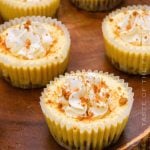
Biscoff Cheesecake
You'll love this recipe for mini Biscoff Cheesecake made with a Biscoff cookie crust, a creamy filling, and topped with crushed Biscoff too. Plus it's easily adaptable to make a single full-size 9" cheesecake too.
Servings 24 mini cheesecakes
Calories 232kcal
Equipment
- muffin tin
- Stand mixer
Ingredients
Crust
- 2 cups Biscoff cookies crushed crumbs
- ½ cup butter melted - unsalted
Filling
- 16 oz cream cheese - softened
- 1 cup granulated sugar
- 4 eggs
- 2 tbsp lemon juice
- 3 tbsp all-purpose flour
- 2 cups vanilla Greek yogurt
Topping
- 1 cup heavy whipping cream
- ¼ cup confectioner’s sugar
Instructions
- Preheat the oven to 325 degrees. Place cupcake liners in the pan.
- Crush the Biscoff cookies into small pieces and crumbs. Some small chunks are okay - does not need to be finely ground.
- Add the melted butter and mix until the butter is incorporated and the mixture has a wet appearance.
- Scoop out one heaping, loosely packed tablespoon of the crust mixture and place it in the bottom of the cupcake-lined baking pan. Using the back of the tablespoon or the flat bottom of a ¼ cup measuring cup, gently press down to pack the crust into the bottom of the pan. Repeat with the remaining crust mixture. Set aside.
- In the bowl of a stand mixer, combine the sugar and softened cream cheese - beat until smooth. Take your time with this step - if the cream cheese is not incorporated well enough or it is cold, there will be chunks in your cheesecakes. Make sure the mixture is creamed together well. Add in the eggs and mix until combined.
- Add the flour, vanilla, yogurt, and lemon juice. Beat well again - stop the machine and scrape down the sides and mix again.
- Fill each cupcake liner until just under the rim of the top. Cheesecakes will not overflow when baked. They will puff up slightly during the baking time, but then settle again once cooled.
- Bake in preheated oven for approximately 14-16 minutes. Before removing from the oven, perform a “jiggle test” - gently wiggle the pan and the centers of the cheesecakes should move slightly while the edges remain in place. The cheesecakes will completely solidify once cooled but overbaking until it is completely set makes for a dry and crumbly cheesecake.
- Remove from the oven and allow them to cool to room temperature. Then place them in the fridge for an additional 2 hours to completely set. Do not remove the liners from the pan before they have cooled and solidified, otherwise, you will have a messy, broken cheesecake.
- Once the cheesecakes have cooled, they can be served.
- Just prior to serving, finish the topping.
- Place the whipping cream and confectioner’s sugar in the bowl of a stand mixer and mix on high speed for 1-2 minutes until stiff peaks form.
- Transfer the whipped cream to a pastry bag fitted with a large star tip and gently pipe a dollop of whipped cream on each cheesecake.
- Sprinkle with additional cookie crumbs.
Notes
Storage: Cheesecakes can be stored in an airtight container in the refrigerator for 3 days or frozen for up to 3 months.
Nutrition
Serving: 1g | Calories: 232kcal | Carbohydrates: 19g | Protein: 4g | Fat: 16g | Saturated Fat: 9g | Cholesterol: 68mg | Sodium: 103mg | Potassium: 65mg | Fiber: 0.03g | Sugar: 15g | Vitamin C: 1mg | Calcium: 31mg | Iron: 0.2mg | Net Carbohydrates: 13g